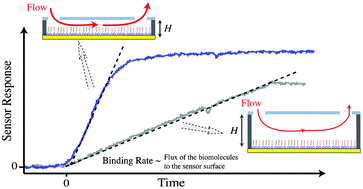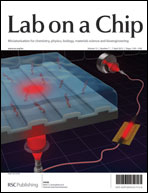Enhancement of affinity-based biosensors: effect of sensing chamber geometry on sensitivity
Abstract
Affinity-based biosensing systems have become an important analytical tool for the detection and study of numerous biomolecules. The merging of these sensing technologies with microfluidic flow cells allows for faster detection times, increased sensitivities, and lower required sample volumes. In order to obtain a higher degree of performance from the sensor, it is important to know the effects of the flow cell geometry on the sensor sensitivity. In these sensors, the sensor sensitivity is related to the overall diffusive flux of  . We verify this scaling behavior via both numerical simulations as well as an experimental surface plasmon resonance (
. We verify this scaling behavior via both numerical simulations as well as an experimental surface plasmon resonance (


 Please wait while we load your content...
Please wait while we load your content...